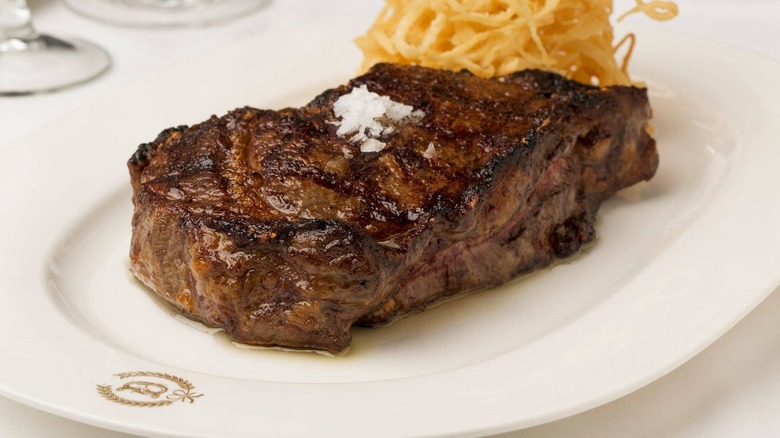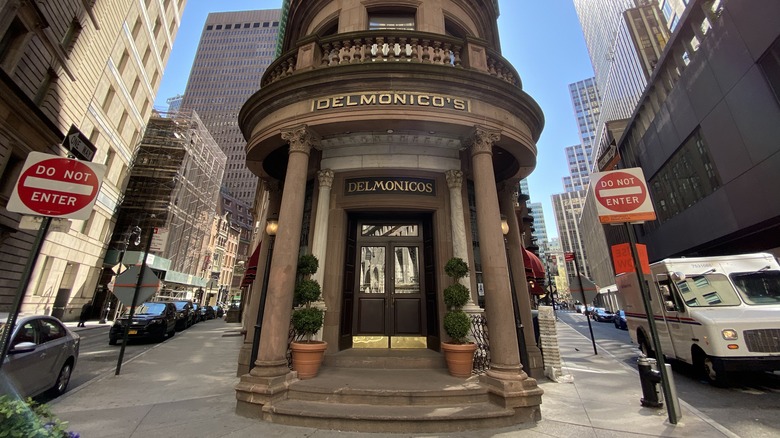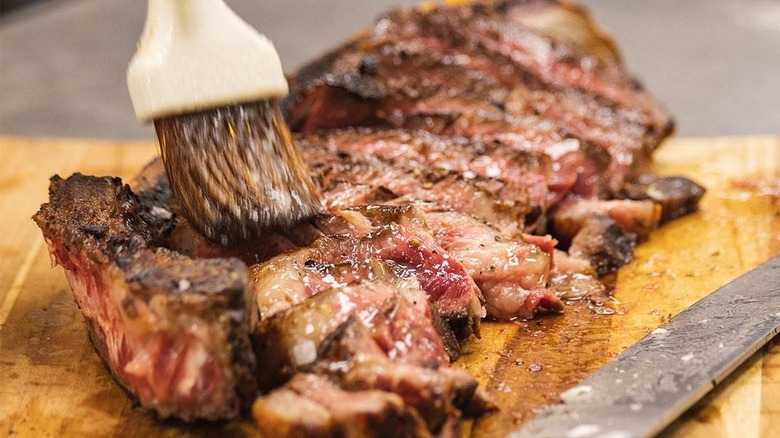The Reason Delmonico's Steak Tastes So Good
Few restaurants, if any, can rival the name recognition of Delmonico's. Opened in 1837, Delmonico's shaped American fine dining as the first a la carte restaurant in the country. It is still open today, despite some turbulent times and a few temporary closures, and is approaching 200 years in business. To stay popular for that long, you must be doing something right, and for Delmonico's, the secret is in their steaks.
Delmonico's was not originally a steakhouse. In fact, one of its most famous claims to fame is being the rumored origin of Eggs Benedict, but today, the name is synonymous with steak, particularly the thick-cut boneless ribeye cut known as a Delmonico steak, which the restaurant started serving up in 1937 (after a whole century in business!). Beginning in the 1990s, Delmonico's fully embraced the steakhouse identity and is now known for serving up some of the nation's most popular steaks. While it's often said that steaks should be kept as simple as possible, the chefs at Delmonico's take it up a notch with a few pro secrets that include brushing it with beef fat and butter and topping it with seasoning.
The secret is in the finishing
Like most acclaimed steakhouses, Delmonico's ages its beef before cooking it, which is the first key to unlocking new levels of flavor. The most popular technique for aging beef is dry-aging, where steaks are kept in a climate-controlled room for weeks. Delmonico's ages most of its steaks from 28 to 45 days, depending on the type of cut. The famous Delmonico steak is not dry-aged, but rather wet-aged, a similar technique in which the beef ages in its own juices. These are fairly standard practices at steakhouses, and they make a huge difference, but at Delmonico's there's one more step after the steak is cooked.
As soon as a steak comes out of the broiler, Delmonico's chefs brush it with a combination of butter and beef fat, which melts into the hot meat. They finish it off with a sprinkling of flaky sea salt and a special pepper blend called Pierre Poivre No. 7 from New York-based spice company La Boîte. It includes eight different varieties of peppercorn, and was once described by The New York Times Magazine as, "tasting the way neon looks". The typical practice of seasoning steaks with only salt and pepper is here maintained, yet also elevated.
How to replicate a Delmonico's steak at home
Unless you happen to find yourself in Manhattan with $90 of steak-spending money in your pocket, your best shot at a Delmonico's-style steak would be to make it yourself. You can buy dry-aged steaks from certain butchers (consider calling in advance to reserve your cut of choice) or you can simulate the process yourself using home dry-aging kits, which are widely available online. Alternatively, you could opt for the wet-aging method used for Delmonico's namesake steak, which is easy to do at home.
To recreate Delmonico's steak finishing technique, buy some beef tallow and mix a bit of it with softened butter. Cook your steaks on high heat to get a nice sear, and when you pull them off the heat, brush on that tallow/butter blend. You can find flaky salt in any grocery store to finish it off with (Delmonico's uses Maldon sea salt). Pierre Poîvre will be trickier to find, as it is almost exclusively sold at stores in New York. However, you can buy it online, or try making your own multi-pepper blends using black, white, red, and green peppercorns. Make sure to follow the lead of Delmonico's chefs and save the pepper blend for last. Add it to the steak before cooking and the pepper might burn. Plus, a little finishing flourish just feels fancy, doesn't it?


